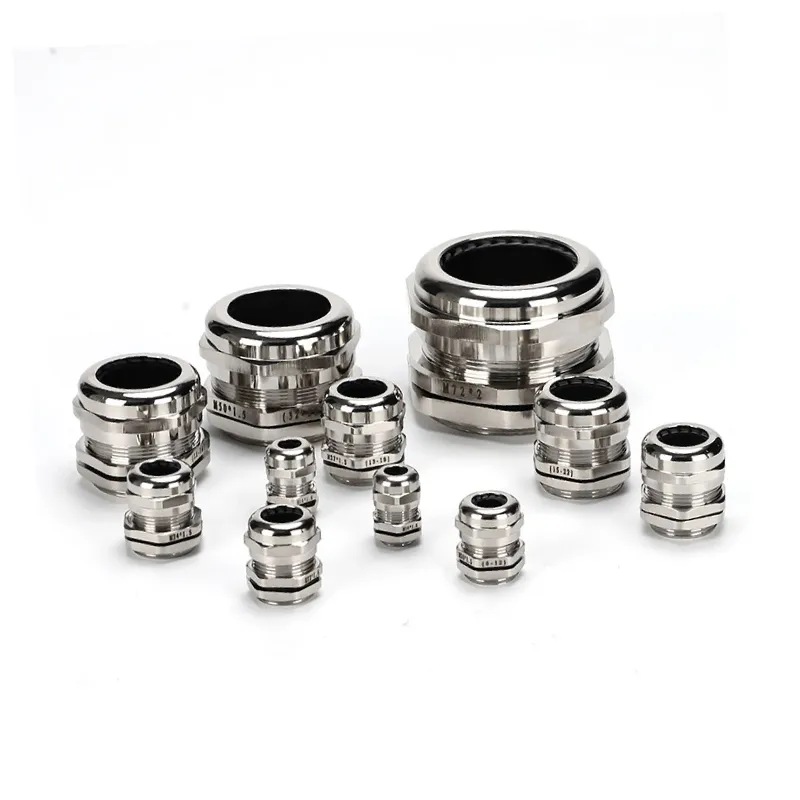Produksjonen av kabelgjennomføringer i metall er et sofistikert samspill mellom metallurgisk ekspertise, presisjonsteknikk og streng kvalitetssikring. Disse kritiske komponentene, som er utformet for å sikre og beskytte elektriske forbindelser i bransjer som spenner fra romfart til offshore-energi, gjennomgår en omhyggelig orkestrert produksjonsreise. Denne rapporten sammenfatter innsikt fra industriell praksis, tekniske spesifikasjoner og materialvitenskap for å beskrive den komplekse prosesskjeden som ligger til grunn for produksjonen av kabelgjennomføringer.

Grunnleggende design og materialvalg
Integrering av beregningsbasert design
Produksjonsprosessen starter med avansert beregningsmodellering, der 3D CAD-programvare genererer presise spesifikasjoner som tar hensyn til mekaniske belastninger, varmeutvidelseskoeffisienter og elektromagnetiske interferensprofiler. Ingeniørene integrerer finite element-analyse (FEA) for å simulere spenningsfordelingen på tvers av komponenter under driftsforhold, og optimaliserer geometrier for strekkfasthet på over 500 MPa i varianter av rustfritt stål.
Valg av materiale
Materialvalg spiller en avgjørende rolle:
- Messinglegeringer (CuZn39Pb3): Brukes til generelle bruksområder på grunn av høy maskinbearbeidbarhet, korrosjonsbestandighet og forlenget levetid takket være nikkelbelegg.
- Austenittisk rustfritt stål (AISI 303/316L): Foretrukket i marine og kjemiske miljøer, med overlegen gropbestandighet.
- Aluminiumslegeringer (6061-T6): Ideell for fly- og bilindustrien på grunn av det optimale styrke/vekt-forholdet.
Spesifikasjonene følger standarder som BS EN 62444 for kabelretensjonskrefter og IP68-protokoller for inntrengningsbeskyttelse, validert via CFD-modeller (computational fluid dynamics).
Teknikker for presisjonsproduksjon
Metallurgisk prosessering
Prosessen begynner med støping eller smiing:
- Investeringsstøping: Støtter komplekse geometrier med dimensjonstoleranser på ±0,15 mm og inkluderer varmebehandling etter støping for strukturell stabilitet.
- Varm smiing: Forbedrer utmattingsmotstanden med 40% sammenlignet med maskinering gjennom kornflytjustering.
CNC-maskineringsoperasjoner
CNC-maskinering med flere akser sikrer presisjon, inkludert:
- Snu deg: Gjenger maskinert med overflatefinish Ra ≤1,6 μm og vedlikeholdt i henhold til nøyaktige ISO 68-1-spesifikasjoner.
- Fresing: Muliggjør konturer for antivibrasjonsflenser og tilhørende komponenter.
- Boring/gjengetapping: Opprettholder vinkelrettheten innenfor 0,02 mm/mm for kabelgjennomføringer og danner innvendige gjenger.
Etterbearbeiding med slipende strømningsmaskinering (AFM) fjerner mikroavbrenninger og sikrer IP68-tetning.
Integrering av monterings- og tetningssystemer
Protokoller for montering i flere trinn
Komponentintegrering følger nøyaktige protokoller:
- Installasjon av tetninger: O-ringer av fluorsilikon presspasset med grensesnittrykk >3,5 MPa.
- Panserklemme: Kaldsmidde messinghylser gir en uttrekksmotstand på over 1,5 kN.
- Momentbegrensende montering: Pneumatiske drivere gir et kontrollert dreiemoment (12-35 Nm) samtidig som man unngår overkompresjon.
Avanserte mekanismer med dobbel forsegling sikrer heliumlekkasjer < 1×10-⁶ mbar-L/s under testing.
Kvalitetssikring og validering av ytelse
Metrologisk verifisering
Kritiske dimensjoner verifiseres ved hjelp av CMM med laserskanningshoder. Gjengekonsentrisitet, samsvar med Go/No-Go-mål og andre finjusterte toleranser kontrolleres nøye.
Stresstesting av miljøet
Batchprøvetaking gjennomgår strenge tester, blant annet
- Termisk sykling: -40 °C til +150 °C over 250 sykluser for å overvåke tetningens kompresjonsinnstilling.
- Saltspraytesting: Sikrer passivering av rustfritt stål i henhold til ASTM B117-standarden.
- Vibrasjonstesting: Bekrefter holdbarhet under tilfeldige vibrasjonsprofiler (MIL-STD-810G).
Elektrokjemisk impedansspektroskopi (EIS) forhindrer at messingkomponenter blir utsatt for avzinking.
Bærekraftige produksjonsinnovasjoner
Materialsystemer med lukket kretsløp
Bærekraftig praksis inkluderer:
- Gjenvinning av messingspon for opptil 98% materialgjenvinning.
- Vannbasert fornikling for å redusere mengden farlig avfall.
Energieffektive prosesser
- Pulse Electroplating: Reduserer energiforbruket med 40% samtidig som du får et jevnt belegg.
- Regenerative termiske oksidasjonsapparater: Fanger opp og gjenbruker varme fra støpeoperasjoner, noe som reduserer VOC-utslippene.
Konklusjon
Produksjonen av kabelgjennomføringer i metall er et godt eksempel på møtet mellom tradisjonell metallurgi og Industri 4.0-teknologi. Fra beregningsmodellering til bærekraftige produksjonsinitiativer - i alle ledd legges det vekt på presisjon og miljøvennlig forvaltning. Etter hvert som industriens krav utvikler seg, innoverer produsentene med materialer som grafendopede kompositter og additive produksjonsteknikker, noe som sikrer at disse viktige komponentene fortsetter å være relevante i den globale elektrifiseringsinfrastrukturen.


